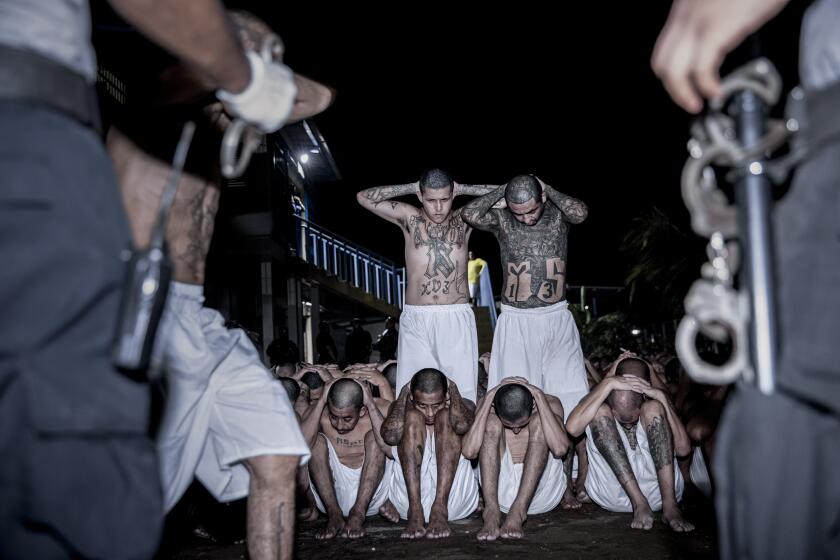The Soldier Who Loved Reporters : A BRIGHT SHINING LIE<i> by Neil Sheehan (Random House: $24.95; 775 pp., illustrated; : 0-394-48447-9) </i>
In the summer of 1962 in Vietnam’s Mekong Delta, where America’s boundless self-confidence was leading it to war with Communist revolutionaries, a charismatic U.S. Army officer grew impatient with his superiors who ignored his arguments that the war was not going well.
Lt. Col. John Paul Vann, senior adviser to the South Vietnamese 7th Infantry Division, turned in frustration to the tiny colony of American reporters then based in Saigon to help advance his notions that Vietnam was a winable war.
It was love at first sight.
Vann’s view was that victory in Vietnam was possible, but only with a drastic change in American strategy and the coercion of the South Vietnamese side into accepting his leadership and that of other American officers in the field.
Despite what he read in the New York Times, President John F. Kennedy did not lose confidence in his generals and stuck by them. So did Lyndon Baines Johnson, who would eventually commit half a million ground troops to the war.
Vann quit the Army in 1963 because, he said, he was disgusted with the conduct of the war. But a legend had been born of his death-defying bravery and his moral heroism in criticizing the war. And with Vann’s return to Vietnam in 1964 as a lowly civilian province adviser, and his rapid advancement to the command of 800 Americans devising pacification strategy in the Three Corps region at the height of the war in 1967, Vann’s legend was embellished.
On his death in a helicopter crash in 1972 after helping South Vietnamese soldiers fight off a Communist offensive against the central highlands city of Kontum, Vann was seen by some of his ardent press admirers as a latter-day Lawrence of Arabia. He received a hero’s funeral at Arlington National Cemetery. His family visited the White House for the personal condolences of President Richard Nixon.
Neil Sheehan took the Vann legend as a launching pad for a history of the Vietnam War. As a young reporter for UPI in Saigon in the early days, he had benefited professionally from Vann’s critical disclosures, as had David Halberstam of the New York Times.
Later, while on the staff of the New York Times, it was Vann’s connections that led Sheehan to Daniel Ellsberg and the publication of the secret history of the war, the Pentagon Papers.
Sheehan had earlier written a critically acclaimed book, “The Arnheite Affair,” about the misbehavior of a U.S. Navy officer in Vietnam.
John Paul Vann turned out to be much more--and much less--than the cardboard hero of legend. Through an odyssey of research over 15 years that took him back in time through Vann’s early Army career and to his childhood in Norfolk, Va., Sheehan reveals the full complexities of the hidden man behind the public image.
Relentlessly, Sheehan builds up a case history of an illegitimate son born in 1924 to a prostitute mother who neglected him. Vann’s youth at the height of the Depression was spent in shame, accompanied by “hunger and pain and raggedy clothes,” with never a tree for Christmas or a turkey for Thanksgiving.
Military service was the escape for Vann, first into the Army Air Corps during World War II, then to Korea with an infantry division, and finally to Vietnam.
But while Vann’s military service allowed him to escape his trash-filled house in Norfolk, Sheehan writes that he could never escape the memory of his mother’s perfidy, and victimized women for the rest of his life.
No sexual indiscretion seems too minute for Sheehan’s perusal, but he reveals that it was finally a sexual sword that Vann fell upon to ruin his Army career. While attending the Army’s Command and General Staff College at Fort Leavenworth in 1958, Sheehan writes, Vann seduced a 15-year-old baby sitter. He beat charges of statutory rape by outwitting a lie detector, Sheehan says, but the accusation of rape would have barred him forever from promotion to general.
The accounts of Vann’s sexual exploits are the shocking fruits of Sheehan’s meticulously honest approach to the whole subject of Vietnam. In a work that must rank with David Halberstam’s “The Best and the Brightest” and Frances Fitzgerald’s “Fire in the Lake,” Sheehan’s “A Bright Shining Lie” successfully tackles the question of why America got into Vietnam in the first place.
Sheehan blames what he described as “the fatuously optimistic colonel blimps” whose professional arrogance, lack of imagination and moral and intellectual insensitivity misled a succession of Presidents. The book title underscores the charade of victory dreams woven by American officials and generals running the war.
But in detailing the life of John Paul Vann and his desperate drive to beat the odds--and the Communists, Sheehan is underscoring the desperation of America, spending its own drive in a war that would ultimately end an era of boundless American self-confidence. The wasted gallantry of those years shares Sheehan’s pages along with the ugliness.
This reviewer was a Saigon press corps member who thought he knew Vann well and benefited from his counsel over the years. I often wondered at the source of his unflagging anti-communism at a time late in the war when the endurance of the rest of America for the war had given out. To learn from Sheehan’s book that Vann was motivated as much by his desperate need to vindicate his shameful past with success in war, as he was by an intelligent, patriotic assessment of the situation, is a sobering reminder of America’s cross-purposes in Vietnam. Fifty-eight thousand Americans and hundreds of Vietnamese died in an attempt to achieve political and military ends that history is showing were always probably unattainable.
Ultimately, Vann’s death was in vain. Vann himself didn’t know it. What he knew was that he had convinced President Nixon that the policy of Vietnamization--reinforcing the South Vietnamese while withdrawing the Americans--would succeed. By wielding B-52 bombers as others might swat flies, Vann himself succeeded in saving Kontum from a Communist offensive in 1972. He died believing the war was won. But Nixon, having exhausted his capacity to manipulate public opinion, used the respite to negotiate a settlement with Hanoi that doomed the South Vietnamese when the next crisis arose in 1975.
Sheehan’s “A Bright Shining Lie” will probably disturb those who still see Vietnam as a sacred American crusade. But Sheehan’s skill in interpreting the war through the flawed personality of John Paul Vann will help others relive the war again--but this time with understanding.
More to Read
Start your day right
Sign up for Essential California for news, features and recommendations from the L.A. Times and beyond in your inbox six days a week.
You may occasionally receive promotional content from the Los Angeles Times.






